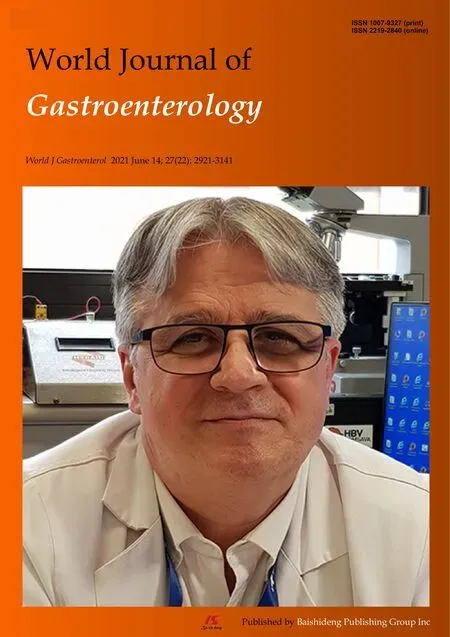Idiopathic mesenteric phlebosclerosis associated with long-term oral intake of geniposide
2021-06-24YangWenYouWeiChenAiHongMengMingZhaoSongHuaFangYanQingMa
Yang Wen, You-Wei Chen, Ai-Hong Meng, Ming Zhao, Song-Hua Fang, Yan-Qing Ma
Abstract
Key Words: Idiopathic mesenteric phlebosclerosis; Phlebosclerotic colitis; Chinese herbal liquid; Geniposide; Colonoscopy; Computed tomography
INTRODUCTION
Idiopathic mesenteric phlebosclerosis (IMP) is a rare form of ischemic colitis that usually affects the right hemicolon. It is almost exclusively observed in Asian populations, is characterized by calcification of mesenteric veins and thickening of the wall of the right hemicolon. The etiology and pathogenesis remain unclear, but it is thought that long-term and frequent ingestion of biochemicals and toxins are associated with the disease[1 ,2 ]. As clarified by existing studies, long-term intake of herbal medicines or medicinal liquor containing geniposide is recognized as one of the major causes of IMP[2 ,3 ]. In this study, we describe 8 patients with mesenteric phlebosclerosis with long-term exposure to Chinese herbal medicines or medicinal liquor. The clinical manifestations and imaging features were summarized, and the relationship between the alcohol index and the severity of IMP observed by computed tomography (CT) were analyzed. This is an interesting article on a relatively rare disease and may present insights into the etiology of IMP.
MATERIALS AND METHODS
Ethical approval
This was a retrospective study, and the data originated from the medical records at Zhejiang Provincial People's Hospital from June 2016 to December 2020 . The study was approved by the Institutional Review Board at Zhejiang Provincial People's Hospital. Informed consent was waived; patient confidentiality was protected.
Patient selection
The medical records of patients meeting the following inclusion criteria were retrospectively reviewed: (1 ) The clinical diagnosis of IMP was confirmed by abdominal CT, endoscopy, or pathology including at least one complete abdominal CT examination with or without intravenous contrast medium injection; and (2 ) Patients had complete clinical information.
Clinical data collection
Eight patients were identified and their clinical data, including symptoms, anamnesis,history of herbal medicines, and therapy, were collected. Patient herbal medicine history, herbal medicine names, contact time, and daily intake were highlighted. Of note, 7 patients consumed similar dosages of two medicines, Wu chia-pee liquor and Wanying die-da wine for a long time. Moreover, the degree of the two wines was similar. The drinking index was calculated as the daily intake (mL) × drinking duration (years).
Gastroscopy procedures
Gastroscopy was performed with an Olympus 290 colonoscope (Olympus, Tokyo,Japan). The endoscope was inserted to 5 -10 cm from the terminal ileum. The color of mucosa, the vascular textures of the terminal ileum, ileocecal area, ascending colon,transverse colon, descending colon, sigmoid colon, and rectum were noted, and the presence of congestion, edema, erosion and ulcer were verified. Multiple samples of the intestinal mucosa were collected for histopathological examination.
CT acquisition
CT scans were generated with a 64 -channel multi-detector CT scanner (Somatom Definition Flash, Siemens Medical Solutions, Forchheim, Germany). The CT scanning parameters were: Detector collimation, 1 mm; pitch, 1 .5 :1 ; tube voltage, 120 kV; tube current, 120 -250 mAs; rotation time, 0 .33 s. Contrast-enhanced CT was performed with 80 -90 mL of 370 mg I/mL iodinated contrast agent (Ultravist, Bayer Schering Pharma AG) injected in a peripheral vein with a dual high-pressure syringe at a flow rate of 2 .2 -3 mL/s. A bolus-tracking technique was used to obtain arterial- and venous-phase CT images with delays of 10 s and 50 -65 s after a 100 Hounsfield unit threshold of the descending abdominal aorta. Image reconstruction was performed with a 1 mm slice thickness and a 1 mm slice interval with an Application Development Workstation(MM Reading, syngo.via, Version VB20 A, Siemens Healthcare GmbH, Forchheim,Germany).
Assessment of the disease CT score
The CT imaging characteristics were assessed by 2 radiologists with 5 - and 10 -year of clinical experience. The severity of IMP was assessed with consideration of the calcification distribution at the tributaries of the portal vein and the range of thickening of the intestinal wall. Colonic wall thickening was defined as a lumen width exceeding 2 cm and wall thickness exceeding 5 mm. The CT scores of the IMP cases are listed in Table 1 ). A 4 -grade calcification score was evaluated by the scope of mesenteric venous calcification of the colon[4 ]. Specifically, venous calcifications limited to the straight vein were scored as 1 , and calcifications extending to the paracolic marginal vein were scored as 2 . If the calcifications extended to the proximal part of main branch of the mesenteric vein, the score was 3 . If the distal end of the main branch was involved, then the score was 4 . Illustrations of calcification distribution are shown in Figure 1 ). The severity of colon wall thickening was classified by three scores depending on the extent of the lesion. Lesions confined to the ascending colon had a severity score of 1 . Those extending to the traverse colon had a severity score of 2 , and those involving the descending colon or distal segment had a severity score of 3 . The calcification and colon wall thickening scores were summed to obtain the disease CT score.

Table 1 Imaging characteristics of lesions on endoscopy and computed tomography
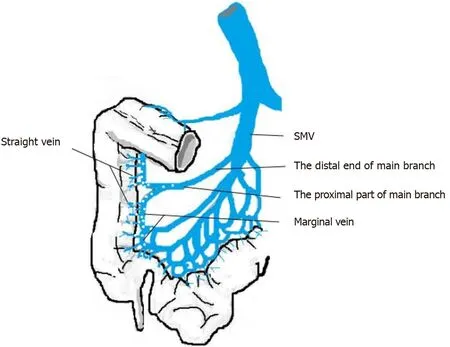
Figure 1 Graphical illustration of the distribution of calcification in the superior mesenteric vein. SMV: Superior mesenteric vein.
Statistical analysis
The statistical analysis was performed with the Statistical Package for the Social Sciences (SPSS version 25 .0 , IBM Corp, Armonk NY, United States). Spearman’s correlation analysis was used to assess the correlation between the drinking index and the disease CT score. Two-tailedPvalues of < 0 .05 indicated statistical significance.
RESULTS
Eight male patients with an average age of 75 .7 (range of 59 –88 ) year were included.Five presented with abdominal symptoms (e.g., abdominal pain, fullness, and diarrhea), one of whom had an intestinal obstruction. All 8 patients had histories of long-term use of Chinese herbal medicines or medicinal liquors. One had used an oral liquid for the treatment of chronic rhinitis. The 7 others had used Chinese medical liquors that contained gardenia, chuan xiong, and angelia dahurica. Tables 2 and 3 show the patient clinic characteristics and the ingredients that Chinese traditional medicines had in common. The patients all received conservative treatment.
All patients presented with punctate or linear calcification on CT images. Mesenteric venous calcification involved the ascending colon of all patients and extended to the transverse colon in 4 (Figures 1 and 2 ). In 2 of the 8 patients, the lesions extended to the descending colon. In 1 patient, the entire colon was involved (Figure 3 ).Calcification was limited to the right-side mesenteric vein in 6 of the 8 cases (75 %). In 2 cases (25 %), the left-side mesenteric vein was involved. Diffuse wall thickening in the affected region was observed in 7 patients. One patient presented with calcification without obvious thickening of the colon wall. The wall thickening was most often seen in the right and the transverse colon.
The median disease CT score was 4 .88 (n = 7 ) and the median drinking index was 5680 (n = 7 ). The dispersion diagram in Figure 4 shows the relationship between the drinking index and the disease CT score. Spearman correlation analysis found a significant positive correlation between the alcohol drinking index and the disease CT score (r= 0 .842 , P < 0 .05 ). In the 4 patients evaluated by of colonoscopy, blue or dark blue colored mucosa was the most characteristic variation. The colonoscopy revealed multiple erosions and ulcers in 1 patient (Figure 5 ). Table 1 lists the characteristic endoscopic view and CT findings. Histopathology of the biopsy samples showed the deposition of collagen fibers in the subepithelium and around the blood vessels. The vitreous deposits were negatively stained by Congo red and appeared blue following Masson-trichrome, staining, which indicated lamina propria hyalinization and fibrosis(Figure 6 ).
DISCUSSION
IMP, which is also known as phlebosclerotic colitis, is a rare intestinal ischemia syndrome with gradual onset and progression. It is characterized by thickening of the wall of the right hemicolon and calcification of mesenteric veins. Most cases have been reported in East Asian nations and regions, especially Japan and Taiwan. In 1991 ,Koyamaet al[5 ] initially described the disease. To distinguish this disease from ischemic colitis associated with arterial diseases, it was termed as “phlebosclerotic colitis” by Yaoet al[6 ] in 2000 . In 2003 , Iwashita et al[7 ] advocated the term “idiopathic mesenteric phlebosclerosis”, as the affected site of this disease showed weak inflammatory changes. Most ischemic bowel diseases result from an insufficient arterial supply attributed to atherosclerosis, thrombosis, and embolus[8 ]. Disturbed venous return may also cause colitis, including IMP as described here. IMP is usually attributed to chronic ischemia of the colon resulting from calcification of the mesenteric venous system that causes venous congestion of the colon and even hemorrhagic infarction.
The disease incidence is low, with mostly chronic and insidious onset. Patients subject to IMP usually present with nonspecific symptoms (e.g., abdominal pain,diarrhea, nausea, and vomiting). As the disease mostly involves the right colon,abdominal pain is more common in the right lower abdomen. Patients may be asymptomatic in the early stage of disease but may develop intestinal obstruction and even perforation in the advanced stage of the disease[9 ,10 ]. In this study, most of the 8 patients developed abdominal pain and diarrhea. One presented with intestinal obstruction as the first symptom, and another presented with gastrointestinal bleeding, which was basically consistent with existing reports.
The pathogenesis and etiology of IMP remain unclear. IMP is characterized by a defined area and endemic population distribution, and a relationship with a regionspecific lifestyle stressed the etiology of this disease[11 ]. Long-term and frequent ingestion of biochemical substances and toxins is considered to be associated with the disease. Most reported cases of IMP have been associated with the use of herbal medicines and medicinal liquor, most of which contained gardenia fruits[12 ]. Gardenia fruit is the dried mature fruit ofGardenia jasminoidesEllis. It is a popular crude drugused as a Chinese herb and has been extensively employed for treating cardiovascular,cerebrovascular diseases, hepatobiliary diseases, and diabetes. The main active ingredient of the gardenia fruit is geniposide. As deduced by some scholars, if patients take Chinese herbal drugs containing Gardenia for a long time, the geniposide can be hydrolyzed to genipin by bacteria in intestinal tract, and the absorbed genipin reacts with the protein in mesenteric vein plasma. In addition, collagen gradually accumulates under the mucosa, which subsequently progresses to hyperplastic myointima in the veins, accompanied by fibrosis/sclerosis. The changes ultimately result in venous occlusion[13 ]. As geniposide refers to one type of glycoside, orally administered geniposide is not directly absorbed after reaching the lower digestive tract. Geniposide is hydrolyzed only after entering the cecum and ascending colon and then transformed to its metabolite, genipin, which permeates the enterocyte membrane as impacted by numerous bacteria in the colon[12 ]. The transformation and absorption processes have been largely identified in the right colon and transverse colon, which explains the characteristic lesion site of mesenteric venous sclerosis.

Table 2 Clinical characteristics of patients with idiopathic mesenteric phlebosclerosis

Table 3 Composition of Chinese herbal liquid medicines
As shown in Table 2 , a clear male predominance was found among the patients.This trend is different from the female predominance described in existing reports from Japan and Taiwan, which might be explained as follows. In Japan and Taiwan,herbal prescriptions containing geniposide are commonly used and are thought to be effective for female-specific symptoms, which may account for the female predominance[14 ,15 ]. However, most of our patients had a history of taking Chinese medical liquors for a long time. Most were male, which may be the reason for male predominance in our study. Region-specific lifestyle may thus contribute to the understanding of the etiology of this disease. In this study, 7 patients had a history of taking the Chinese medical liquors named Wu chia-pee liquor and Wanying die-da wine, which consist of multiple Chinese herbs soaked in liquor and have various effects (e.g.,enhancing fitness and optimizing immune responses)[3 ,14 ]. Another patient had no history of drinking alcohol and had been taking Biyuanshu oral liquid for a long time to treat chronic rhinitis. The medical liquids used by our 8 patients all contained geniposide, chuan xiong, and angelia dahurica (Table 3 ). A study by Hiramatsuet al[14 ] of 25 IMP patients in which geniposide was the only Chinese medicine common to all is further evidence the that Chinese herbal medicines containing geniposide are involved in the pathology of IMP. Nevertheless, whether geniposide is only factor directly involved in the pathogenesis of IMP, or whether it is accompanied by other Chinese medicine in the pathogenesis of IMP, needs to be further determined in larger datasets.

Figure 2 Abdominal computed tomography shows colonic wall thickenings with threadlike calcifications (arrow) of the superior mesenteric vein in the transverse colon and ascending colon. A-C: Case 2 ; D-F: Case 4 . Three-dimensional maximum intensity projection reconstruction of computed tomography angiography effectively illustrates the extent of calcification along the mesenteric vein (C, F).
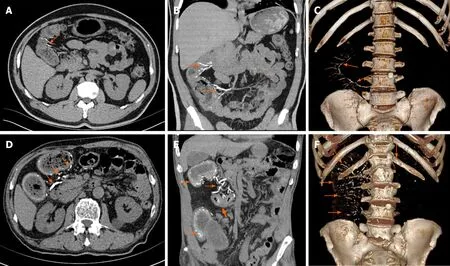
Figure 3 Abdominal computed tomography shows numerous linear and arc-like dense calcifications (arrow) distributed within the bowel wall of the ascending and hepatic flexure of the colon with thickening of the colon wall. A-C: Case 1 ; D-F: Case 5 . Case 5 Local stenosis is seen in the transverse colon of case 5 (thick arrow). Volume rendering image shows that calcifications were more prominently distributed in the mesenteric veins in the right hemicolon (C, F).
The clinical symptoms of IMP lack specificity, and the diagnosis is largely determined by the results of radiology and colonoscopy[9 ,16 ]. Abdominal CT scans show calcifications of the involved superior mesenteric vein and its branches, which are linear and follow the course of the blood vessels. The involved colon wall becomes swollen and thickened[17 ]. Endoscopy shows a blue or bluish purple mucosa at the lesion site[18 ], and the color might be attributed to chronic congestion with ischemia or toxins that stained the bowel mucosa[19 ]. Tortuous and irregular veins can be seen under the mucosa with poor light transmission. In severe cases, the vessels might disappear. Colonic mucosa was Hyperemia and edema of the colon are sometimes accompanied by erosion or ulcer. The lesions are continuous and the chronic course of disease involves spread from the ileocecal to the anal side. IMP mainly affects the right colon but may also involve the left colon and extend to the sigmoid colon, but generally does not involve the terminal ileum.
In this study, 2 patients had phlebosclerosis extending to the left colonic vein branch, 1 had chronic nephritis, and 1 had been treated 5 years previously with endocrine and radiotherapy for prostate cancer, which are rare in IMP[2 ,20 ]. The investigators speculated that poor renal function and long-term treatment of malignant tumors prolong the clearance of genipin, an active metabolite of geniposide,which allows genipin to accumulate in the branches of the veins following absorption,thus aggravating the severity of mesenteric venous sclerosis and reducing the absorption capacity of the colon. Genipin, that is not completely absorbed by the ascending and transverse colons, is absorbed from the left colon, leading to sclerosis and calcification of the left colon venous branch. In addition, systemic microvascular disease complicating diabetes and resulting in chronic hypoxia may increase the vulnerability of colon wall and colon vein[1 ]. Consequently, chronic nephritis,malignant tumors, and diabetes may increase the risk of the progression of IMP, as shown in Figure 6 .
As shown in Figure 7 , the severity of IMP is related to the drinking index, which reflects the daily intake of liquid medicine and the duration of contact. The effect on vessel wall is time- and dose-dependent, and that may be related to colonic flora and colonic absorption capacity. IMP has characteristic manifestations on both CT and endoscopy, which make it is relatively easy to diagnose. Conventional histopathology shows fibrosis and calcification of the vein wall and collagen deposition around the vessels. Because of the superficial location of the lesions, the pathological value of the specimens taken during colonoscopy for the diagnosis of IMP is limited, and the resected specimen may require in-depth observation. The treatment strategy for IMP can be determined on an individual basis. Patients with mild or asymptomatic symptoms can be treated conservatively, which will stop progress after the exposure to pathogenic ingredients is stopped (e.g., the use of Chinese herbal medicine). Surgical treatment is necessary if severe complications such as colonic obstruction, necrosis,perforation, or massive intestinal bleeding occur[21 ]. However the presence of poor circulation may mean that colon surgery is not an appropriate treatment, and it must be chosen with care.
CONCLUSION
This study evidence supports geniposide as most likely to be involved in the pathology of IMP. Clinical conditions including chronic nephritis, malignant tumors,and diabetes mellitus, may be the risk factors of IMP. It is recommended that longterm use of Chinese herbs and medical liquors should be avoided, especially prescriptions or formulations containing gardenia. Both endoscopic and radiologic examinations can lead to a conclusive diagnosis even if biopsy results are insufficient or inconclusive.
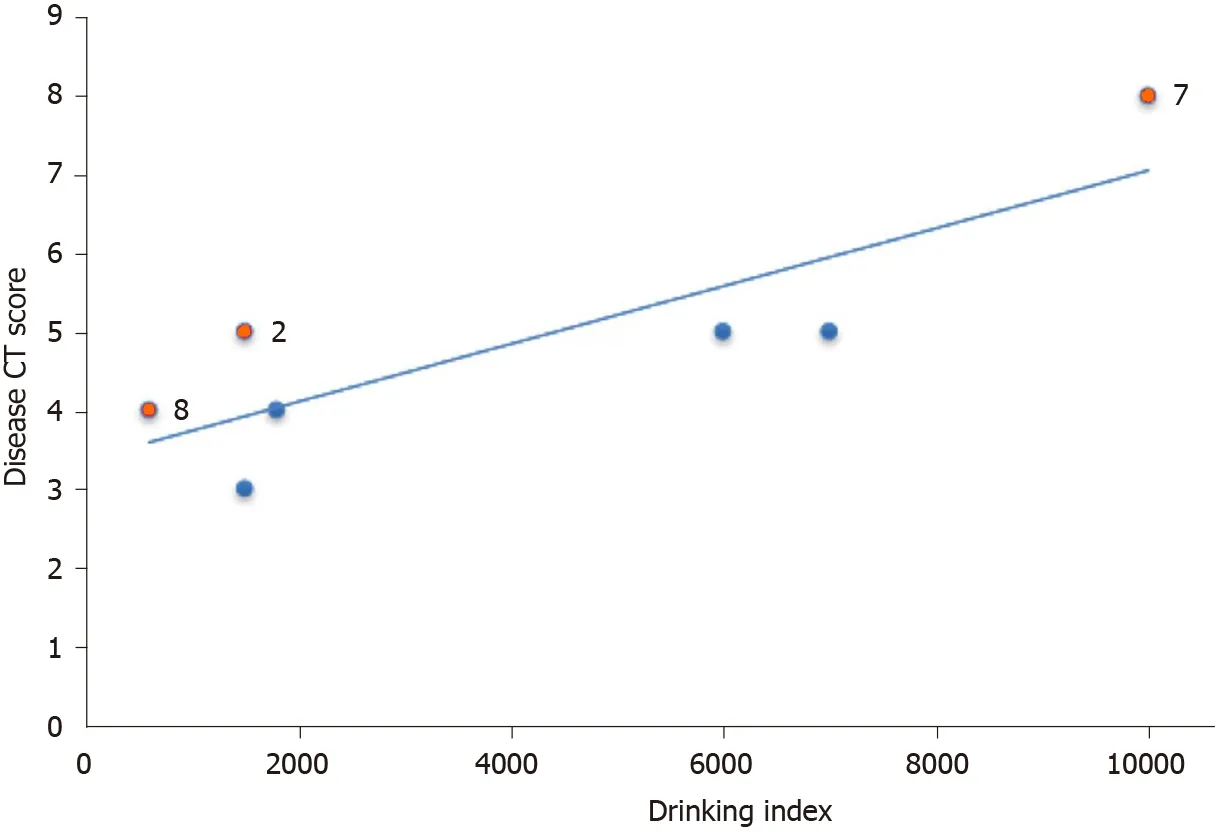
Figure 4 Dispersion diagram and best fitting line for the drinking index vs the disease computed tomography score. Patients two, seven, and eight had histories of diabetes, chronic nephritis, or prostate cancer are shown by red dots. CT: Computed tomography.
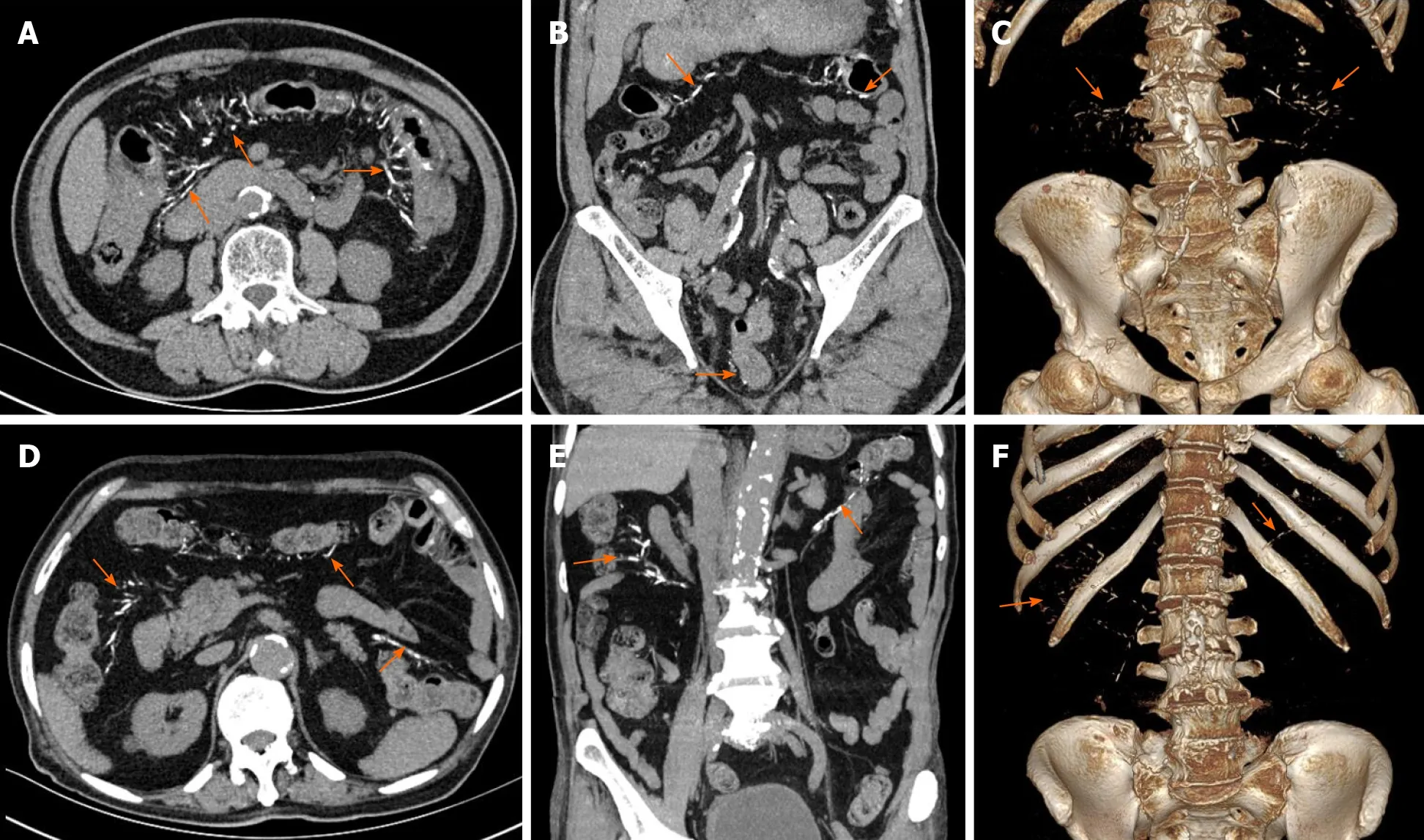
Figure 5 Abdominal computed tomography shows multiple threadlike calcifications within the colon wall and adjacent vein from the ileocecal junction to the descending colon (arrow). A-C: Case 6 ; D-F: Case 7 . In case 6 , calcifications of the mesenteric vein extended to the rectum; mild diffuse thickening of colon wall is seen. Volume rendering image illustrates the distribution of calcifications in the mesenteric veins, the inferior mesenteric vein with multifocal calcifications (C, F).
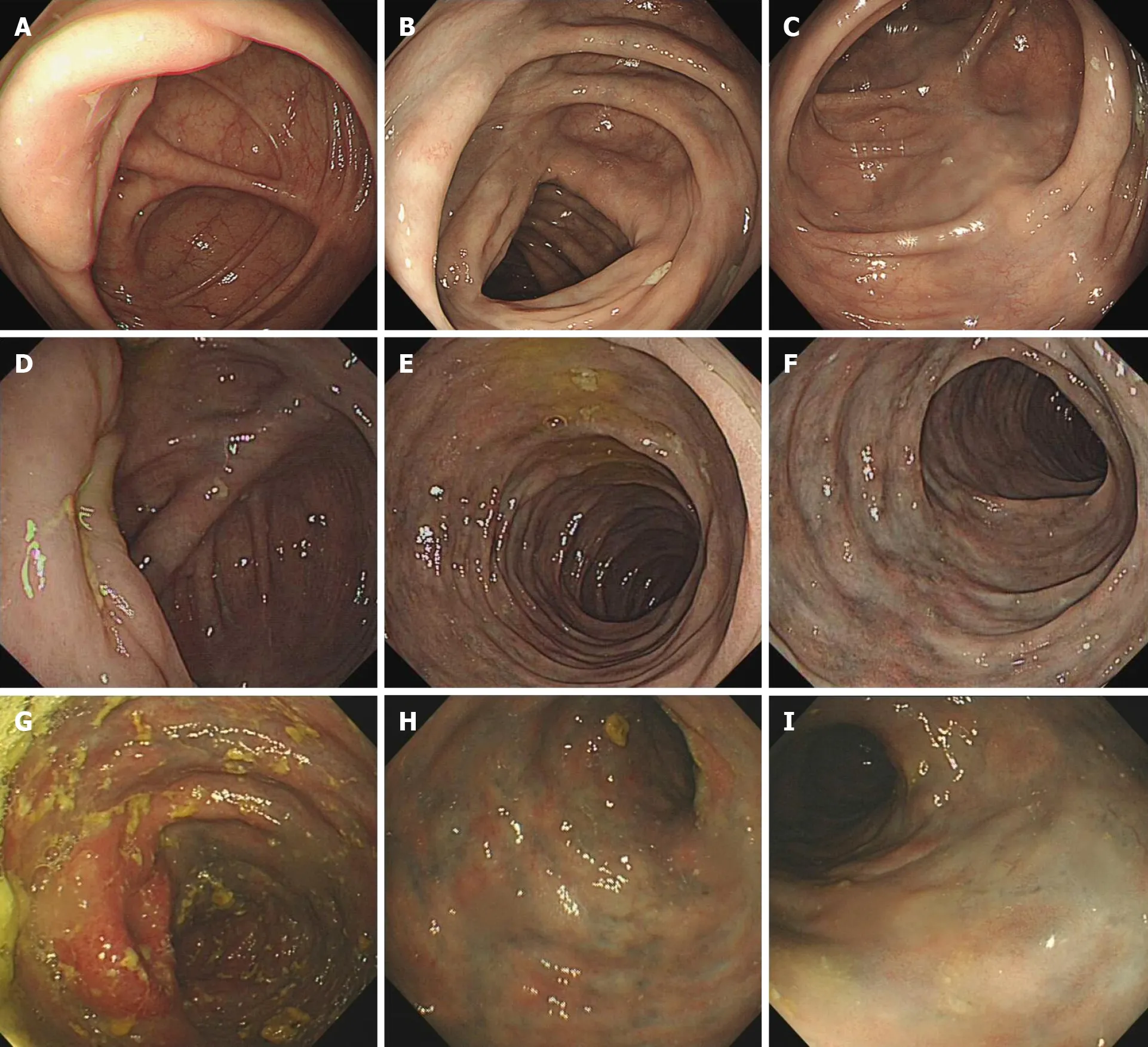
Figure 6 Representative endoscopic views. A-C: Colonoscopy in case 3 revealed light blue discoloration in the transverse colon; D-F: Colonoscopy case 2 showed edematous congested mucosa with pigmentation, and dark blue discoloration extending to the transverse colon; G-I: Colonoscopy of case 5 revealed edematous dark purple colonic mucosa and sclerotic changes of the colonic walls extending from the cecum to the splenic flexure of colon.

Figure 7 Histologic examination of the biopsy specimen of case 2 . A: Hematoxylin and eosin staining revealed marked fibrosis of the deep layer of the mucosa wall thickening of the venules (× 40 ); B: Masson’s trichrome stain indicated that the deposits were stained blue, suggesting that they were collagen fibers (×40 ); C: Congo red staining revealed absence of vitreous deposition, excluding amyloidosis (× 40 ).
ARTICLE HIGHLIGHTS
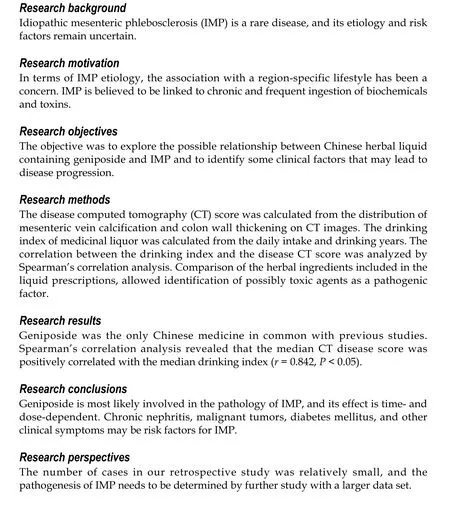
杂志排行
World Journal of Gastroenterology的其它文章
- Fecal microbiota transplantation for irritable bowel syndrome: An intervention for the 21 st century
- Hepatocellular carcinoma in viral and autoimmune liver diseases: Role of CD4 + CD25 + Foxp3 + regulatory T cells in the immune microenvironment
- Application of artificial intelligence-driven endoscopic screening and diagnosis of gastric cancer
- Mucosal lesions of the upper gastrointestinal tract in patients with ulcerative colitis: A review
- Preservation of superior rectal artery in laparoscopically assisted subtotal colectomy with ileorectal anastomosis for slow transit constipation
- Early serum albumin changes in patients with ulcerative colitis treated with tacrolimus will predict clinical outcome
